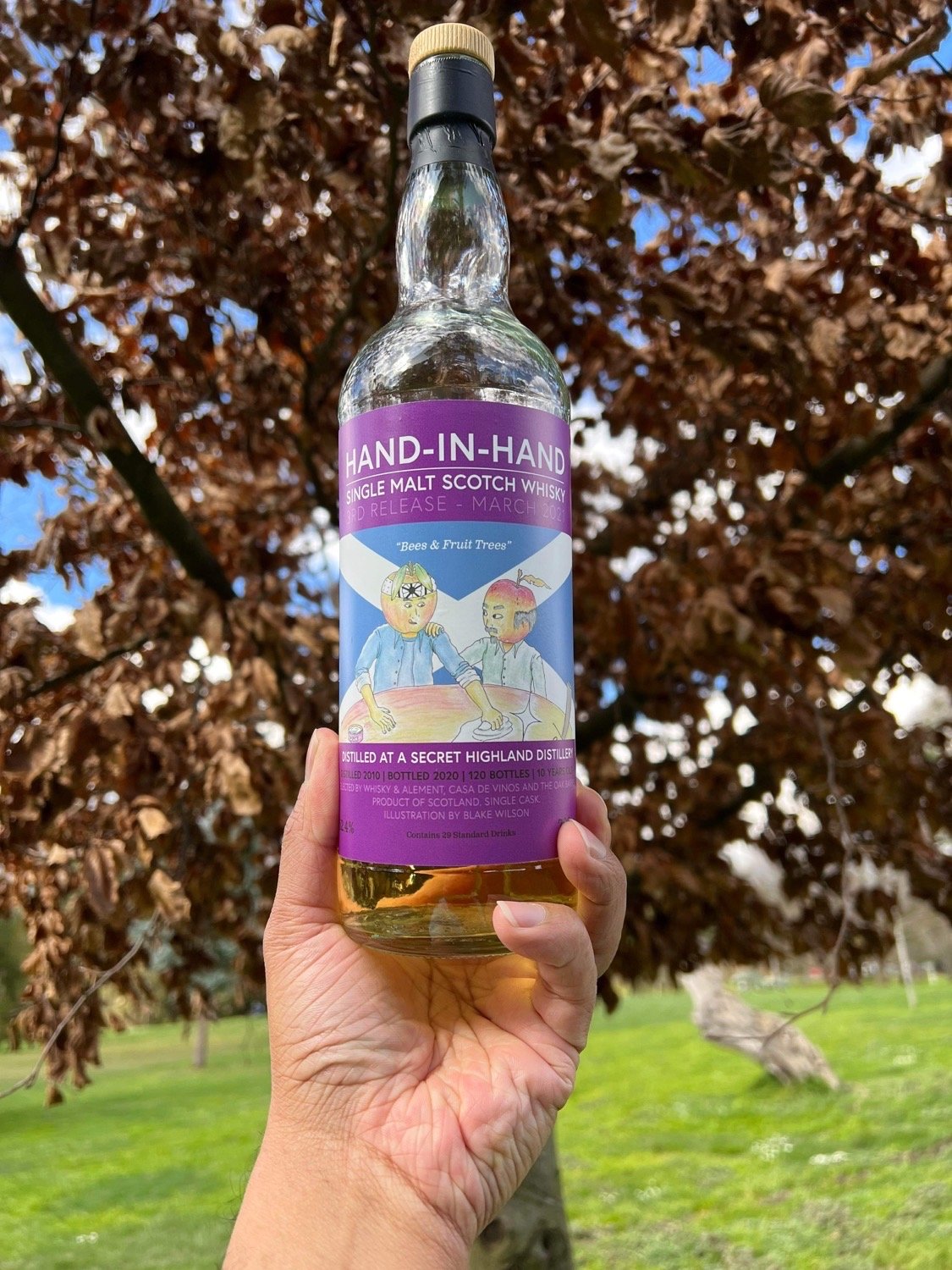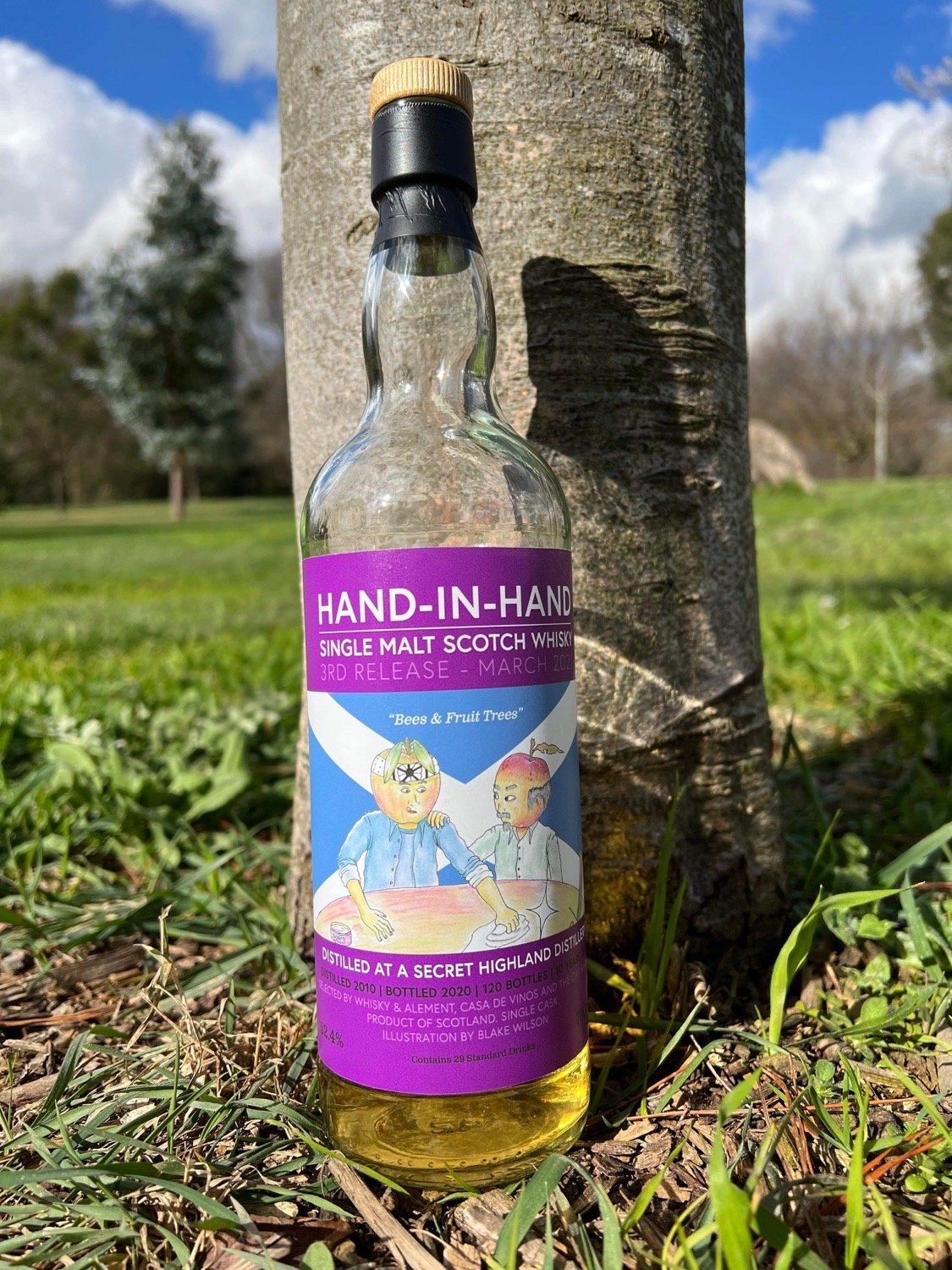Secret Highland 10 Year Old
Hand In Hand 3rd Release | 52.4% ABV
Score: 8/10
Something special.
TL;DR
It’s not too late to join the party
Wax on with your next whisky.
In the ongoing journey as whisky buccaneers, there are many landmarks which inform the portfolio of our whisky horde.
During the early steps of most people’s experience is the transition from blends into single malts. For others, it’s that first taste of Islay ecstasy that often lights a fire, leading to the inevitable ashes of linen cupboards filled with bottles and credit card statements.
For me it was Caol Ila 12, that first taste of citric smoke and flame-kissed fish has informed the fact that more than half my present collection has had some dalliance with peat. Our tastes and preferences change, or at least become more finely tuned the more we immerse ourselves within any experience.
Take chocolate for example. We start off devouring any sugar-spiked cacao bricks as children, but as we get older, we discover there’s a place for dark chocolate. Some people start to become focused on the origin of the bean, Peruvian vs Mexican, or looking into the time spent for the conche.
You could apply this same analogy to coffee. We all start with instant, progress to pods, and inevitably end up looking into natural vs washed, single origin etc. Now it’s okay to stick to coffee pods or supermarket milk chocolate, everything has its place to be enjoyed. But what if we fall victim to our curiosity and we need to search for the depths of what whisky can offer us.
The elephant in the room here with refining our whisky journey really is cost. Sure, our tastes can mature and we can start to enjoy more specific and exclusive bottlings, but progress of our whisky palate doesn’t necessarily advance as fast as our disposable income. So what can we change to further diversify our whisky portfolio? To me, the answer has always been distillate. Once you’ve enjoyed the scent of peat and sweet sherried goodness, there’s a world of flavour to parse through just looking at all the different styles of spirit coming out of Scotland. There’s a statistic thrown around that 60% of a whisky’s flavour comes from the cask. This Australian whisky greenhorn isn’t going to be the one to call blasphemy on that, but at the very least 60% can be quite generous. Putting aside the influence from peat, of which there is an entire ecosystem of flavour derived, there are touchstone notes you can find from different distillates. Your mileage may vary depending on your fanaticism for particular distilleries, or whisky in general, but there are some that have transcended and become part of the common lexicon when discussing bottlings. There is the infamous Springbank funk, which to me has always been this shiitake mushroom or caramelised onion umami. We also have others such as the tropical sweetness of Longmorn, the heather of Highland Park, and lastly, the waxiness of Clynelish.
Depending on where you are right now with your scotch whisky tasting, you might be wondering, “Waxiness? What does that even mean?” We eat mushrooms and tropical fruit so we know how whisky can taste like those foods. We can smell the heather flower and compare that with a dram of Highland Park. But what is our point of reference for waxiness? In fact, why would a whisky even taste like this?!
“Because of the comparatively long time the liquid sits in both the low wines receiver and the feints and foreshots tank prior to being mixed to create the spirit still charge, a build-up of waxiness occurs.”
Clynelish has built its reputation around this association with waxiness. It may be one of Diageo’s prize malt horses, but its infamy goes beyond pure branding. Independent bottlings most often sought, with a primary interest in refill bourbon aged casks, at least in my experience. This method of cask-maturing makes spirit the MVP, no time for tannin when it comes to Clynelish. It’s mutually understood language whenever the word “wax” or the image of a cat is anywhere near an independent bottling of a ‘Secret Highland’ scotch whisky. Really there may not be another single malt that’s so strongly associated with a single adjective. I had my doubts when I first encountered these whiskies. My whisky-senpai, further along in the journey than me, would often talk about the waxiness from a good Clynelish. And so when an Australian-exclusive bottling was available I pounced on it like a cat just to see what all the fuss was about and whether everyone was just brainwashed by some global whisky hivemind.
As I took my first sip of the Clynelish I’m reviewing today, there was only one word in my tasting note mind palace: Wax. I’ve never drunk wax or licked a candle, but there was nothing else this taste could be. Wax, as it had a thick, almost hydrophobic texture coating my mouth. Perhaps this was some sort of primitive infant memory where I sucked on a church candlestick. The association was formed and forever will Clynelish be waxy. Just like that, a tentpole had been formed in my whisky camp; I like waxy, distillate focused whiskies. Unfortunately, so do a lot of single malt whisky drinkers, and independent bottlings are not always easy to find now.
It’s even rarer for there to be an Australian-only independently bottled Clynelish. Aptly named Hand-In-Hand, this finds itself bottled by three east coast whisky icons; Melbourne whisky bar Whisky & Alement, Melbourne bottle shop and newly opened bar Casa De Vinos, and Sydney craft liquor merchants The Oak Barrel. This is as close as a Melburnian can get to a local independent bottler. I must confess it wasn’t only the familiarity with the parties bottling this whisky that persuaded me to purchase, it was honestly the bottle art, I love a good cartoon, and above all, an anthropomorphic apple.
Illustration by ‘The Oak Barrel’s’ Blake Wilson, featuring a cheeky reference to “wax on, wax off” from ‘The Karate Kid’.
Review
Hand-In-Hand 3rd Release: 10 year-old Secret Highland Malt, 52.4% ABV
$199AUD at retail, still available on Australian Whisky Auctions
This was the third release as part of this collaboration. At the time, all three retailers stocked this for about $199AUD. It can be found for more, or paradoxically, less at the occasional Australian Whisky Auction. Matured in a single cask of refill-bourbon wood, there’s no chill-filtration or artificial colouring.
Nose
Applebox honey, canned pineapple and a lit beeswax candle. There is a faint salty lick of coastal air and spring flowers at the tail end of the aroma.
Palate
Mouth coating and oily with wax drippings. A fresh bowl of fruit salad garnished with salt and shreds of spearmint. Oak spices and dehydrated apricots towards the finish, all held tight in a beeswax wrapper.
The Dregs
This discovery felt like arriving last to a great party, the dancefloor no longer rocking, the cake cut, music now slow and sombre, but there are still some nice spring rolls and party pies left to pick at. It may not be the yesteryears where you could leisurely browse through some Clynelish online for a somewhat reasonable price, but you do see them around, albeit mostly young bottlings. This bottle will fit the bill. Yes, it’s only 10 years old, but it tasted like much more, and at the end of the day taste is what counts the most. I think it’s good to go after specific distillates - in the pursuit of key flavours we learn more about the place it’s produced, the processes, and history of a distillery. They are all important as part of our story with whisky, it informs our future purchases and experiences, and helps us make choices which end up having us more rewarded.
Score: 8/10
Tried this? Share your thoughts in the comments below. CD
-
Dramface is free.
Its fierce independence and community-focused content is funded by that same community. We don’t do ads, sponsorships or paid-for content. If you like what we do you can support us by becoming a Dramface member for the price of a magazine.
However, if you’ve found a particular article valuable, you also have the option to make a direct donation to the writer, here: buy me a dram - you’d make their day. Thank you.
For more on Dramface and our funding read our about page here.

































